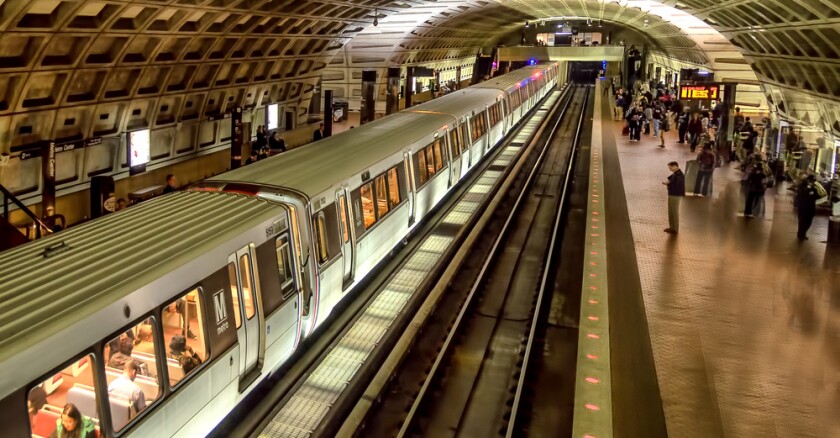In 2022, some 66 percent of commuters in the Washington, D.C., metro region were working from home at least some of the time, an increase from 35 percent in 2019, according to the 2022 State of the Commute Survey Report by the Metropolitan Washington Council of Governments (COG).
Furthermore, for those workers commuting into jobs, a larger share of them have been driving rather than taking public transit. In fact, 78.4 percent of those trips were taken alone in a personal car or ride-hail vehicle in 2022, up 13.8 percentage points from 2019, according to the survey research.
Ridership on Metro, the network of trains and buses serving the nation’s capital, during the first six months of this year was down 64 percent compared to the same six-month period in 2019, according to the American Public Transportation Association (APTA). Metro did not return a request for comment.
“People are still opting to drive if they do have to execute a commute,” said Audrey Denis, strategy manager at Cubic Transportation Systems. Denis also works to help the company understand how technology is evolving for agencies, cities and users of transit. Cubic provides transportation technology for Washington Metro.
“I think it really outlines what the challenge of transit agencies is, as we evolve in this context where people don’t go to work everyday. And I think, to some extent, we are going to see this general decline in the 9-to-5 commute,” she added.
Officials at COG said it’s still too soon to say if the telework trends will continue.
“The amount of teleworking today is less than what it was in 2021 or 2020 and it continues to evolve and change as people and businesses begin to see the full impact of a high level of teleworking,” said Kanti Srikanth, deputy executive director for Metropolitan Planning at COG, in an email, adding that future office space demand and the economic activity it brings “are a complex and evolving issue.”
Several data sources suggest remote work in the capital region may have “plateaued,” even as some large employers and government agencies are signaling a desire to reduce office footprints.
Transit ridership across the U.S. has been sitting steadily at about 65 percent to 70 percent of pre-pandemic ridership across transit networks, according to data from the Transit App. This is an improvement from a year ago, when ridership hovered around 55 percent of pre-pandemic ridership.
These sorts of headwinds, driven by significant changes in the way workers and others move around urban areas, will prompt transit agencies to rethink service delivery and other aspects of their operations, say experts.
The time has come for transit agencies to start thinking of themselves as mobility agencies, said Christopher Coes, assistant secretary for transportation policy at the U.S. Department of Transportation, during the APTA conference in October. Coes offers up a vision of an interconnected mobility ecosystem that facilitates seamless connections across modes and regions.
“What does that national system look like? That is the question we’re asking ourselves at the Department of Transportation,” said Coes.
Other experts stress focusing on transit planning that accommodates all of the other non-work trips we take — errand running, trips to schools and doctor’s appointments.
“I don’t think voters in the future are saying, ‘We just want three more routes.’ How does it connect me to the hospital, to the school?” said Quinton Lucas, mayor of Kansas City, Mo., in some of his comments at the APTA conference.
To serve some of these new trips, transit agencies will need to think about how to provide accessibility and reliability throughout the day rather than just the morning and evening peak commutes, said Denis.
Some of the ways agencies are addressing these challenges: focusing on system reliability; removing friction points for users; launching more mobility options, like small shuttles linking restaurants and attractions; providing on-demand microtransit; and more focus on the first-mile/last-mile obstacles.
“So that micromobility piece seems like it’s going to become much, much more common,” said Denis.
The new normal also means transit will need to be more flexible, quicker to make changes in routing, schedule timing and other areas. Transportation companies like Via are already responding with the launch of its Remix Scheduling tool, which aims to help transit agencies more quickly respond to driver shortages, federal reporting regulations and other operational challenges in one software platform.
“Riders are depending on transit more for essential trips and daily errands, and younger people are less likely than ever to get their driver’s license. All the while, we’re faced with transit driver shortages and unpredictable commuter patterns due to remote work,” said Nithya Sowrirajan, Via’s chief product officer. “That said, it’s crucial for transit agencies of all sizes and settings to have access to smart, simple scheduling software that helps networks remain flexible and nimble.”
Agencies are also putting in place more programs and opportunities to reduce or remove fares altogether. The programs are modeled on account-based fare-payment systems which allow agencies to offer special rates for low-income and other qualified riders.
“How do we make it easier for users to opt for transit,” said Denis, “especially for those rides when they’re not going to work, and it may not be quite as instinctual that you’re going to get on the subway, or get on the bus.”
Government Technology is a sister site to Governing. Both are divisions of e.Republic.












